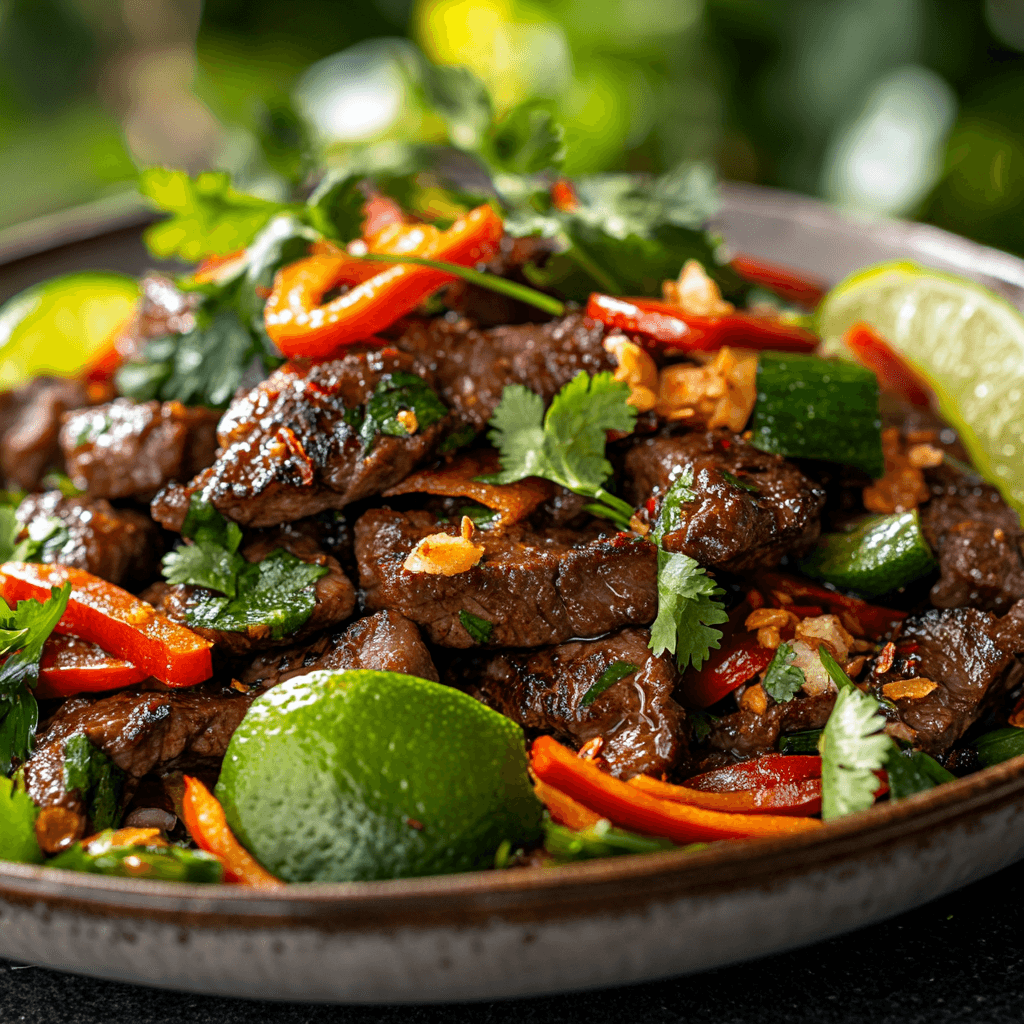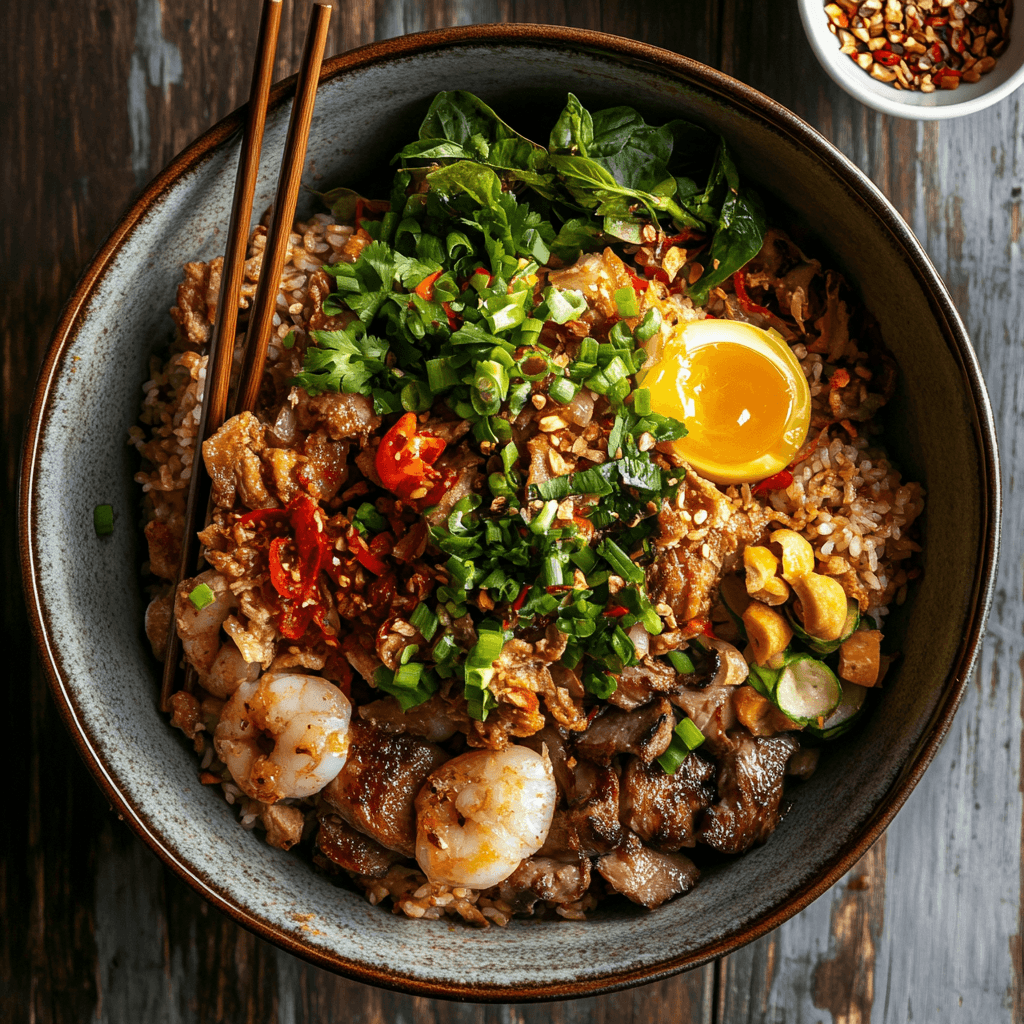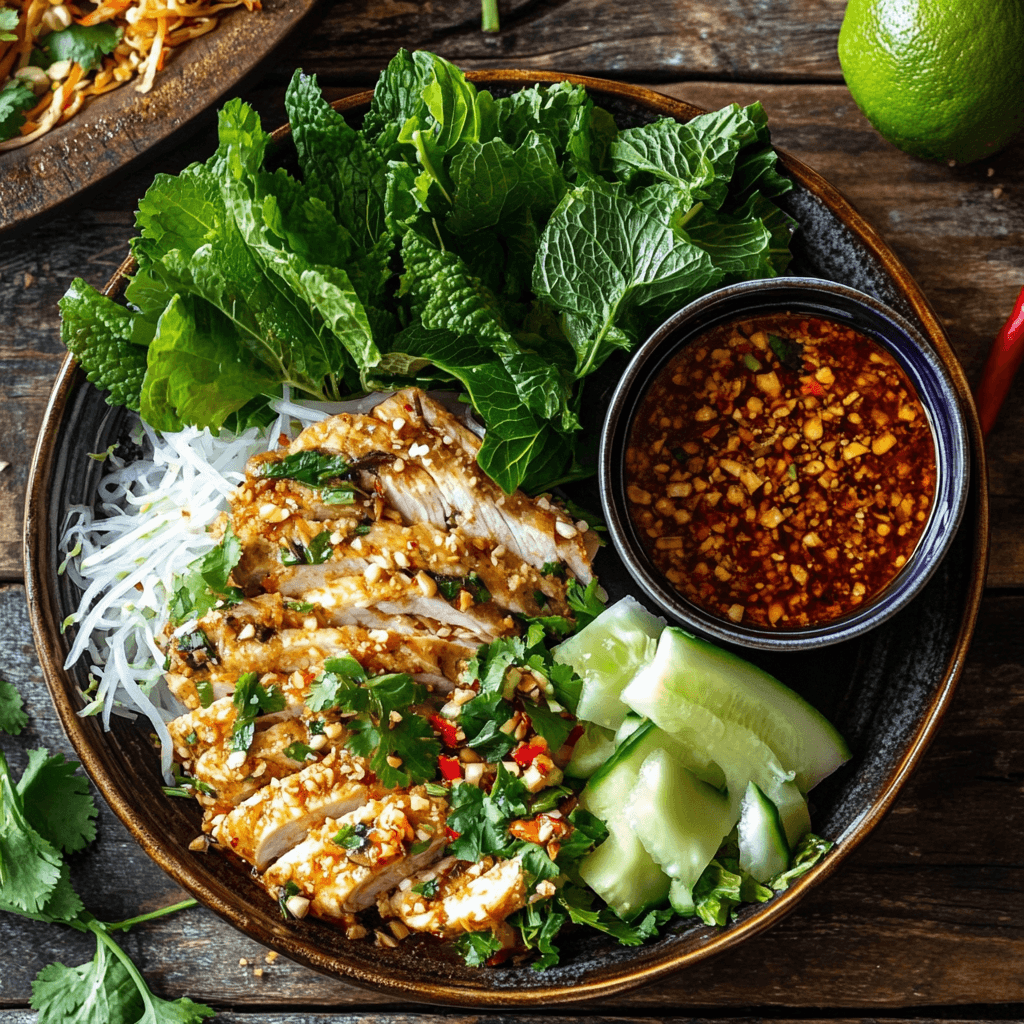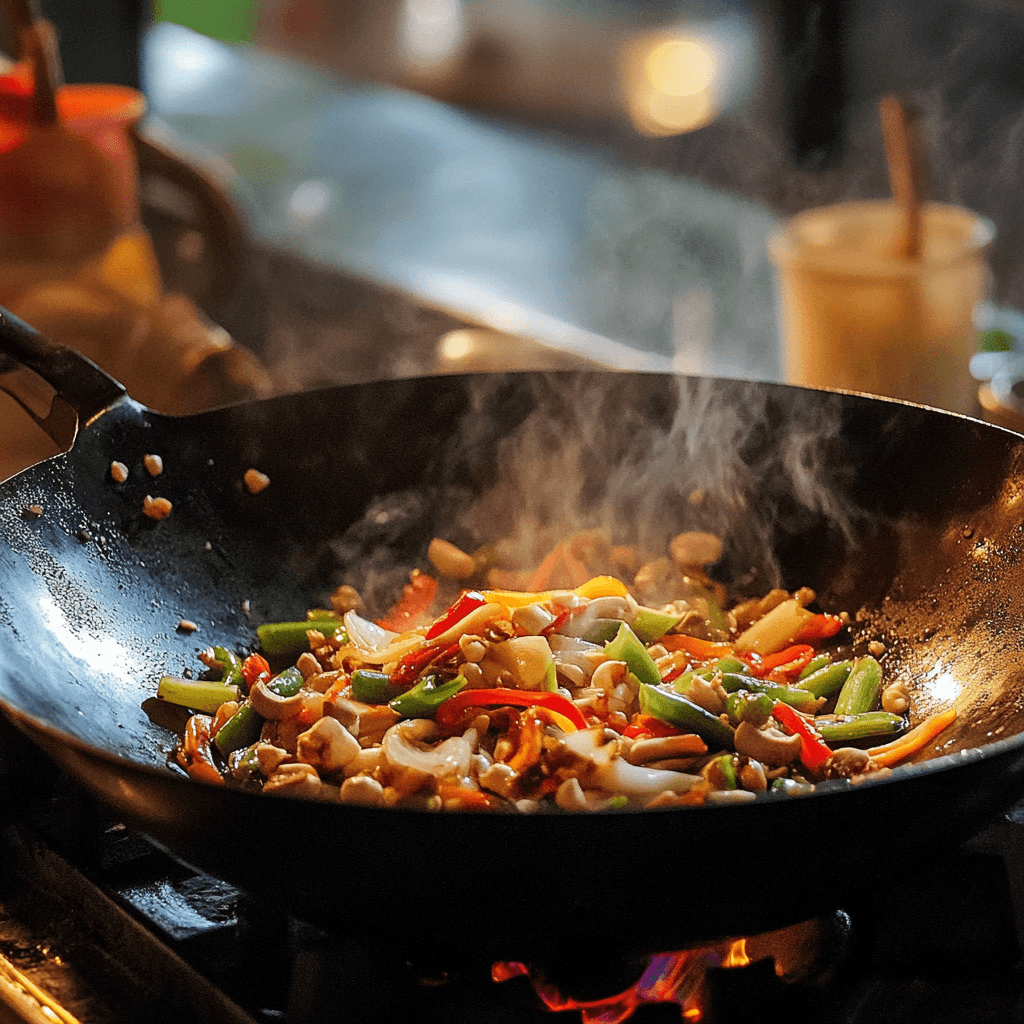Phat si-io is not just a dish; it’s an experience that brings the vibrant flavors of Thailand right into your kitchen. Known for its beautifully thick flat rice noodles and savory sauces, this dish captures the essence of Thai street food in the comfort of your home. Phat si-io harmoniously blends tender noodles with fresh vegetables and proteins, creating a delightful medley of textures and tastes. Whether you’re a seasoned chef or a beginner, mastering this phat si-io recipe will surely impress your family and friends. In this article, you will learn about the essential ingredients, detailed preparation steps, variations, tips, and answers to frequently asked questions to help you create an authentic dish that rivals your favorite Thai restaurants.
What are the Main Ingredients in Phat Si-O?
Essential Ingredients for Authentic Phat Si-io
To make an authentic phat si-io recipe, it’s vital to select high-quality ingredients since they significantly impact the final taste and texture. Here’s a closer look at the key ingredients essential for preparing this delicious dish:
| Ingredient | Amount | Notes |
|---|---|---|
| Flat rice noodles (sen yai) | 10 oz | Fresh or dried; cook according to package instructions before use. |
| Soy sauce | 2 tablespoons | Use dark soy sauce for color and flavor. |
| Oyster sauce | 1 tablespoon | Adds richness; choose vegetarian oyster sauce if desired. |
| Sugar | 1 teaspoon | Balances the saltiness. |
| Vegetable oil | 2 tablespoons | Peanut or canola oil is ideal for frying. |
| Garlic | 2 cloves, minced | Provides aromatic depth. |
| Egg | 1 | Optional, adds protein. |
| Proteins (chicken, beef, tofu or shrimp) | 8 oz | Choose your favorite protein, cut into thin strips. |
| Broccoli or Chinese broccoli | 1 cup, chopped | Adds crunch and nutrition. |
| Carrots | ½ cup, julienned | Offers sweetness and color. |
Table of Contents
High-quality, fresh ingredients are crucial for enhancing the flavors in your phat si-io dish. For instance, using fresh flat rice noodles can elevate the overall texture, making it softer and more pleasurable to eat. If you are using dried noodles, ensure they’re cooked just to al dente, as they will continue to cook while being stir-fried.
Additionally, consider your protein choice carefully. Chicken and pork are traditional options, but tofu or shrimp can cater to different dietary preferences. For a vegetarian approach, remember to use a plant-based oyster sauce. This kind of sauce is made from mushrooms and retains the umami flavor profile.
Nutritional Value of Phat Si-io
Phat si-io not only showcases delightful flavors but also offers several nutritional benefits. The combination of flat rice noodles provides an excellent source of carbohydrates, while fresh vegetables introduce essential vitamins and minerals. This dish typically includes protein sources like tofu or chicken, contributing to a well-rounded meal that can be both satisfying and nutritious.
For health-conscious cooks, it’s essential to control your ingredient choices. If you want to cut calories, consider reducing the amount of oil used for frying and opt for lean proteins. Additionally, incorporating a variety of colorful vegetables can enhance the nutritional profile of your phat si-io, increasing fiber content and essential nutrients. As a guiding principle, aim to fill at least half of your plate with vegetables—this makes for a heartier dish and ensures it aligns with a balanced diet.
How to Prepare Phat Si-io: Step-by-Step Instructions
Cooking Instructions for Phat Si-io
Creating phat si-io may seem intimidating initially, but it is quite straightforward when you break it down into clear steps. Here’s a detailed and actionable guide:
- Prepare the Noodles: For dried flat rice noodles, begin by cooking them according to the package instructions until they’re just al dente, which usually takes about 5-7 minutes. Drain and rinse them under cold water to prevent sticking. If you are using fresh noodles, a quick rinse may be all they require.
Heat the Wok: In a large, hot wok or frying pan, pour in your vegetable oil over medium-high heat. Allow the oil to heat until it shimmers, indicating that it’s hot enough for stir-frying. A hot wok is critical for achieving that signature stir-fried texture and flavor.
Sauté the Aromatics: Once the oil is ready, add the minced garlic and sauté it gently. Cook for approximately 30 seconds or until fragrant; be cautious not to let it burn, as burnt garlic can impart a bitter flavor to the dish.
Add Proteins: Next, toss in your choice of protein, be it chicken, beef, shrimp, or tofu. Stir-fry the protein for about 3-5 minutes, or until it’s cooked through. If you’re using multiple proteins, consider adding them one by one based on their cooking time to ensure they’re perfectly cooked.
Incorporate Fresh Vegetables: After the protein is cooked, add the chopped broccoli and julienned carrots to the wok. Stir-fry for an additional 2-3 minutes, letting the vegetables become tender yet still crisp. This step ensures that you maintain the dish’s vibrant colors and nutrients.
Combine with Noodles: Add the cooked flat rice noodles to the wok. Gently toss everything together to ensure that all ingredients, including proteins and vegetables, are evenly distributed throughout the noodles. A spatula works well for this mixing process, lifting and folding the noodles to coat them in the sauce.
Add the Flavors: Pour in the soy sauce and oyster sauce, followed by the sugar. Mix thoroughly, ensuring every strand of noodle absorbs the sauces’ rich flavors. Let the mixture cook for a few more minutes to deepen the flavors.
The Finishing Touch: If using an egg, create a well in the center of the noodle mixture. Crack the egg directly into the center, allowing it to cook slightly before incorporating it into the rest of the dish. This step adds richness and further harmonizes the flavors.
Plate and Serve: Once everything is hot and well-mixed, remove the wok from the heat. Serve the phat si-io hot on a plate, and feel free to garnish it with fresh cilantro or a squeeze of lime for an extra kick of flavor.

Common Mistakes to Avoid When Making Phat Si-io
While making phat si-io might seem quite simple, certain mistakes can affect the overall outcome. To help you navigate this process smoothly, here are some common pitfalls and how to avoid them:
- Choosing the Wrong Noodles: One of the most common mistakes is using the wrong type of noodles. Always opt for flat rice noodles, labeled as “sen yai” in Thai grocery stores. If dried, do not overcook them; they should remain slightly firm.
Overcrowding the Wok: Another frequent error is overcrowding your cooking space. Adding too many ingredients at once lowers the wok’s heat, which results in steaming rather than stir-frying. Instead, consider cooking your ingredients in batches if needed to maintain temperature and achieve that beloved sear.
Not Tasting and Adjusting: Lastly, many cooks forget the critical step of tasting and adjusting the seasoning as they cook. Make it a habit to sample your dish and tweak the flavors. If you find it a bit bland, a splash more soy sauce or a dash of fish sauce can dramatically improve the flavor profile.
By avoiding these common pitfalls and paying attention to details, you enhance your chances of creating a delicious phat si-io that pleases everyone at the table.
Creative Variations of Phat Si-io
Vegetarian and Vegan Phat Si-io Options
Making phat si-io customizable can elevate its appeal, especially for those following vegetarian or vegan diets. To make this dish vegetarian or vegan-friendly, start by replacing the oyster sauce with a plant-based alternative or simply omit it while increasing the amount of soy sauce.
Additionally, introducing a variety of colorful vegetables enhances the dish’s appeal. For instance, consider using snap peas, baby corn, or bell peppers for added texture and sweetness. These veggies bring crunch and further nutrients, making your phat si-io not only appealing but healthy.
Don’t forget to find ways to incorporate protein in your vegetarian or vegan version. Tofu, tempeh, or even chickpeas can serve as excellent substitutes. When crispy and properly seasoned, tofu absorbs the flavors beautifully, complementing the dish’s overall taste.
Overall, making phat si-io adaptable to various dietary preferences not only increases its versatility but also allows you to share it with a wider audience, thereby enriching your culinary repertoire.
Spicing It Up: Adding Heat and Flavor
For those who enjoy a savory kick, adding heat to your phat si-io can enhance its flavor immensely. A great way to introduce some spice is by incorporating sliced Thai bird chilies or a dollop of chili paste during the stir-fry process.
You can also experiment by garnishing your final dish with crushed red pepper flakes or sliced fresh chilies, depending on your heat preferences. This addition will complement the other flavors while bringing a warming exhilaration to the mouth.
Moreover, consider the use of fresh herbs. Topping your phat si-io with chopped cilantro, mint, or Thai basil just before serving contributes fragrant aromas that enhance the overall eating experience. A squeeze of fresh lime juice can lift the flavors considerably, balancing the richness of the sauces beautifully.
Ultimately, experimenting with spices and garnishes allows you to tailor your phat si-io recipe, keeping it fresh and exciting while appealing to varying tastes.

As you prepare your phat si-io, remember that this dish provides endless opportunities for personalization and improvement. Each innovation leads to unique flavor discoveries and makes cooking an enjoyable and engaging experience.
Overview of Preparation Process
With all of these details in mind, your journey in creating the perfect phat si-io recipe becomes easier and more tailored to your preferences. By understanding the fundamental ingredients, following specific instructions, and avoiding common mistakes, you empower yourself to prepare a dish that both tastes authentic and fits your dietary needs.
The next section of our exploration will delve into fascinating FAQs and additional serving suggestions to ensure your phat si-io experience is both enriching and enjoyable. This delightful recipe has the potential to stand out as a staple in your culinary collection, offering not just a meal but an experience infused with the vibrant culture of Thailand.
markdown
How to Make Phat Si-io Step-by-Step (continued)
Finishing Touches and Presentation
After you have stir-fried all the components and incorporated the sauces, it’s crucial to present your phat si-io beautifully.
- Final Adjustments: After mixing everything in the wok, taste the dish once more to ensure it’s seasoned to perfection. If preferred, consider adding more soy sauce for saltiness or extra sugar for balance. Always remember that slight adjustments can make a significant difference in flavor.
Plate It Up: Serve your phat si-io immediately on warm plates. The heat from the dish keeps the flavors vibrant and fresh. When plating, consider using a pair of chopsticks or a large spoon to twirl and arrange the noodles artfully. This attention to presentation not only enhances the dish’s visual appeal but also prepares the guests’ palate for a delightful experience.
Garnishes Add Appeal: You can enhance the dish by garnishing it with fresh herbs like cilantro or basil. A wedge of lime on the side not only adds color but also invites guests to drizzle fresh juice on top before eating. This touch enhances the flavors even more and provides a refreshing acidity that can cut through the richness of the sauces.

Pro Tips for Perfecting Your Phat Si-io Recipe
- Prep Ahead: To make the cooking process smoother, prepare your ingredients before you start cooking. Chop vegetables, slice proteins, and mix sauces. This way, everything is readily available during stir-frying, and you can focus on the cooking process instead of scrambling for ingredients.
Use a Hot Wok: The key to a great stir-fry lies in using high heat. A sizzling hot wok allows the noodles to get a bit charred, which enhances the overall flavor significantly. The right temperature helps you achieve that coveted “wok hei,” the breath of the wok, which adds a unique flavor dimension.
Experiment with Proteins and Veggies: Don’t hesitate to experiment! Try different proteins, like pork or even duck, and various vegetables such as snow peas or bell peppers to create a unique signature dish. This adaptability enhances your cooking repertoire and caters to a wider range of tastes.
Timing is Everything: Stir-frying is a quick process. Ensure that you have all ingredients within arm’s reach so that you can add them promptly without overcooking. Cooking time can significantly impact texture and flavor, so keep a close eye on your ingredients while they simmer together.

Pro Tips & Variations
Creative Serving Suggestions
To further enhance your phat si-io experience, consider serving it alongside various accompaniments. You can create a full Thai-inspired meal by including:
- Thai Spring Rolls: Serve crispy spring rolls as a delightful appetizer to complement your noodles. The light, crispy texture provides a nice contrast to the chewy noodles.
Spicy Dipping Sauce: For those who love extra heat, a side of spicy chili sauce allows guests to add their preferred kick, enhancing the overall dining experience. You can make a simple sauce using fish sauce, lime juice, chopped chiles, and a hint of sugar.
Thai Iced Tea: Pair the rich flavors of the dish with a refreshing Thai iced tea, balancing the savory profile with sweet, aromatic notes. The creamy texture from the condensed milk in the tea contrasts with the bold flavors of the phat si-io beautifully.
Catering to Dietary Preferences
If you need to accommodate dietary restrictions, consider each ingredient’s role carefully:
- Gluten-Free Option: If gluten is a concern, opt for gluten-free soy sauce or tamari instead of regular soy sauce. Always double-check ingredient labels for hidden gluten sources.
Low-Carb Alternative: For those watching carbs, substitute flat rice noodles with zucchini noodles or shirataki noodles, which significantly reduce caloric intake while still offering a satisfying texture. Zucchini noodles provide a fresh flavor, while shirataki noodles absorb the surrounding flavors thanks to their unique porous structure.
FAQs: Common Questions Regarding Phat Si-io
Now that you have a solid understanding of how to make phat si-io, let’s answer some frequently asked questions that can help alleviate any uncertainty while cooking this dish.
What is the Main Ingredient in Pad Thai?
The primary ingredient in pad thai is rice noodles, similar to those used in phat si-io, but pad thai typically includes a sweet, tangy tamarind sauce. The combination of flavors differs in each dish, with pad thai being sweeter and phat si-io focusing on savory soy flavors.
What Ingredients are in Pad See Ew?
Pad see ew shares several similarities with phat si-io, notably using flat rice noodles. However, its sauce typically consists of dark soy sauce, which can give a slightly different flavor profile. Common ingredients include broccoli, meat (or tofu), and a bit of sugar to balance the flavors.
Is Pad See Ew Like Drunken Noodles?
Pad see ew and drunken noodles (pad ki mao) differ primarily in flavors. While both dishes feature flat rice noodles, pad see ew is less spicy and more soy-sauce-focused. In contrast, drunken noodles are known for their bold and spicy flavors, often incorporating fresh basil and chilies.
What are the 5 Flavors of Pad Thai?
Pad thai harmonizes five essential flavors: salty (from soy sauce), sweet (from sugar), sour (from lime), bitter (from bean sprouts), and umami (from oyster sauce). While phat si-io is less complex in flavors, it shares a balance of salty and sweet that makes both dishes appealing.
Additional Common Questions about Cooking Phat Si-io
- How do I store leftover phat si-io? Keep leftovers in an airtight container in the refrigerator for up to 3 days. Reheat gently in a pan with a splash of water to avoid drying out.
Can I freeze phat si-io? While not ideal, you can freeze it for up to one month. Just remember to undercook the noodles slightly before freezing, as they will continue to cook when reheated.
Can I make phat si-io without a wok? You can use a large skillet or frying pan as a substitute. Make sure it has a wide surface for effective stir-frying.
Conclusion
In conclusion, mastering the art of making phat si-io brings an exciting culinary experience to your home. This versatile dish not only allows for creativity in flavor combinations and ingredients but also provides an authentic taste of Thai cuisine that everyone can enjoy. By exploring various variations, accommodating dietary preferences, and considering expert tips, you can truly make this recipe your own.
Indulge in the savory, satisfying delight of phat si-io today, and elevate your dinner game to a new level. It’s more than just a recipe; it’s a culinary adventure waiting to happen—one that promises to impress all who partake in this delicious treat.


